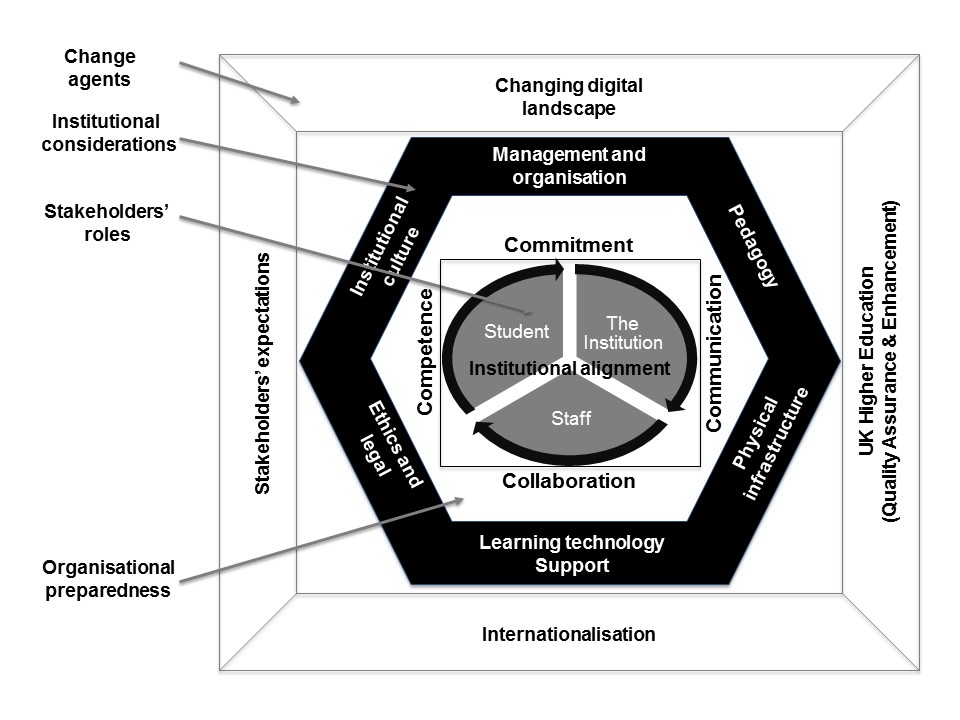Institutional framework to support transitions into enhanced blended learning
Developed as part of the ‘Transitions into blended learning’ project, funded by QAA Scotland under the Enhancement Theme ‘Student Transitions’, this framework forms the basis of a checklist for staff at the University of Glasgow and other institutions wishing to enhance their blended learning provision. Work on the Transitions project was in parallel to the Blended and Online Learning Development (BOLD) initiative, a strategic, institutionally funded project to pump-prime developments in blended and online learning.

Institutional framework to support transitions into enhanced blended learning (Adekola et al, in review).
The framework was developed as a result of 20 semi-structured interviews with key stakeholders across the institution, our analysis being informed by relevant literature. The work identified four overall themes:
- Key drivers for blended learning
- Institutional considerations for blended learning
- Organisational preparedness for blended learning
- Key stakeholders
These overarching themes are presented as a checklist of questions to consider:
1. Key drivers
- How will you prepare to meet stakeholders’ (students’) expectations of blended learning?
- How will you meet the requirements of quality assurance and enhancement in UK HE?
- How will your blended learning design support internationalisation?
- Does your blended learning provision reflect the changing digital landscape, in terms of current and future uses of technology?
2. Institutional considerations
Physical infrastructure
- How will you use physical learning spaces including technology-enhanced active learning (TEAL) or flexible learning spaces?
- Does the teaching room or institution support Bring Your Own Device (BYOD), Wi-Fi, power sockets?
Learning technology support
- Do you know what specialist learning technology support is available to you?
- In your school or department?
- In your college or faculty?
- In your institution?
- Are there ‘early adopters’ in your school, college or institution that you can liaise with?
- Are there ‘communities of practice’ that you can participate in to share ideas and experiences?
- Do you have access to required equipment and services? This may include filming and editing equipment for video, or support for e-assessment.
Pedagogy
- Do you need to reconsider your approach to teaching to encourage greater independent learning in your students?
- How will you use the VLE and associated technologies to support active learning (e.g. rather than as a file repository or transmissive device)?
- How will you design blended learning activities to support a deep approach to learning in your students?
- Is your blended learning curriculum constructively aligned (starting with the intended learning outcomes, then designing the assessment(s), then the learning activities)?
- Does your pedagogy make cultural assumptions? How will it support students from various countries, in terms of their previous experience and transition into blended learning, as well as the needs of their future employers as they transition out of university?
Management and organisation
- Is your school/college/institution supportive of blended learning?
- Is there linkage between high-level strategy and operational delivery?
- Is there a clear line of communication?
- Are there appropriate structures in place to effect that line of communication?
Institutional culture
- Is the school/college/institution progressive with regards to learning and teaching?
- How will you and others manage the associated risks of innovation?
- Are there opportunities to learn from challenges or from failures?
Ethical/legal
- Does the blended learning design support the needs of a diverse cohort of learners?
- Is your blended course or programme accessible to all learners?
- Do your learners all have access to devices and Wi-Fi?
- Are there any technical issues that limit access to some learners (e.g. compatibility with mobile devices, or support for video on different devices)?
- Are you complying with copyright requirements?
- Can you advise your students on copyright compliance and other aspects of digital professionalism?
3. Organisational preparedness for change
- What opportunities are there for communication between stakeholders?
- What opportunities are there for collaboration between stakeholders, e.g. staff-student partnership working and co-design of curriculum?
- How will you ensure the competence of all stakeholders (staff and students, in terms of digital literacies or capabilities)?
- How will you secure the commitment of all stakeholders (for example, management should secure commitment of staff through appropriate reward and recognition; teachers should secure commitment of students by engaging them as partners in learning and teaching or at least engaging in dialogue to align expectations of staff and students)?
4. Stakeholders
- Are the roles of students, staff and management sufficiently clear?
- Are the requirements and practices of these stakeholder groups effectively aligned through communication, collaboration, commitment and competence?

